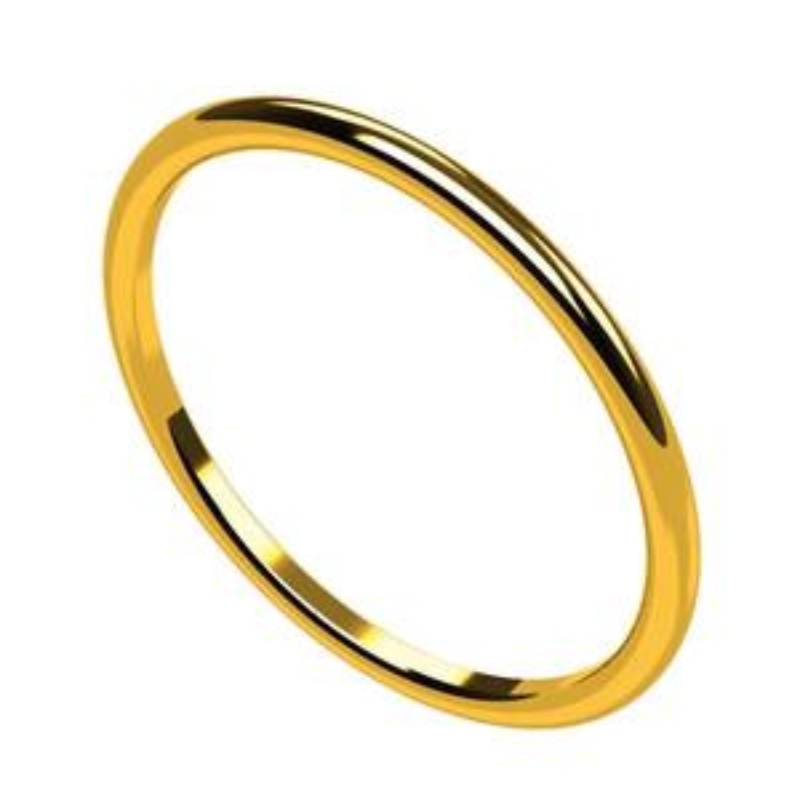Blog
24 Karat Gold Ring: Everything you Need to Know!

Are you planning on proposing the love of your life? If yes, then the first hurdle that you need to cross before getting a yes or no is to find a perfect engagement ring. With limitless options available you can choose anything that will best reflect the love and adoration that you have for them. From platinum to sterling there are plenty of metals to pick.
But gold has a different kind of charm making it a more ideal option amongst new couples. The gold rings especially 24 karat gold rings are declarations of elegance, style, and sophistication. They often symbolize wealth, luxury, and prosperity. Let’s explore more 24 karat gold engagement ring and why you should consider it as an option.
History of Gold Rings
Gold rings are one of the oldest types of jewelry, and their history goes back centuries. The first gold rings date to around 2800 BC and were found in ancient Egyptian tombs. During the Middle Ages, gold rings became popular in Europe. In early Rome, rings were initially crafted from iron to use as seals. Jus annuli aurei, the right to wear gold rings, was initially reserved for senators.
Over time, the privilege to wear gold rings was extended to all civilians. Artisans developed the technique of combining gold with other metals to improve its durability, laying the groundwork for today’s karat system.
Gold ring benefits
Timeless Elegance
Gold rings have symbolized beauty and luxury for centuries, making them a timeless and classic choice that never goes out of fashion.
Versatility
The most appealing aspect of gold rings is their versatility. These rings can be dressed up for any event.
Design Variety
You can find a wide range of rings to match your style. Gold ring varieties include 24k gold diamond ring, engagement rings, and everyday wear rings.
Affordability
You don’t need a fortune to own a precious gold ring. By choosing a ring with lesser karat you buy one for your beloved as well.
Symbolize love and commitment
Gold rings have been a traditional symbol of love and commitment for centuries. Whether you want to give someone a gift or are searching for an engagement ring, no other surprise can beat a gold ring.
Different Colors and Styles of Gold Jewelry
Gold, often perceived as a single yellow hue, comes in a surprising array of colors.
- The classic yellow gold, for instance, is a blend of sterling silver, copper, and zinc.
- White Gold is created when yellow gold is alloyed with nickel, palladium, and zinc. It gets its bright, silver-like white finish from Rhodium plating.
- Rose gold, also known as pink gold, is made by mixing gold with copper alloys.
What is 24-karat Gold?
Typically, gold is an alloy, meaning it is mixed with other metals, but 24k gold is exclusively made of 100% gold. The karat of gold measures the amount of actual gold in it. This measure is out of 24 parts. Thus, the 24 karat gold means all 24 parts have gold in it. Similarly, 18-karat gold would consist of 75% gold and 25% other metals, and so on.
Despite its high value and beauty, 24k gold is not commonly used for jewelry for daily wear as it is very malleable and gets scratched easily. Alloy gold is more substantial and more suitable for jewelry, particularly rings. So, you can explore 24k gold jewelry online shopping websites and check whether this is the best option for you or not.
Advantages of 24k Gold
- Gold may be a beneficial financial investment due to its easy buying and selling in pure form.
- Inert 24k gold will never undergo a reaction with any element, and its color and integrity will remain unchanged.
- Allergic reactions can be caused by the metals found in lower-karat gold jewelry. Allergies are less likely to be concerned with 24k gold, as it is pure gold.
Downsides of 24k gold
- As 24k is a pure metal, it is very prone to scratching, making it less suitable for jewelry.
- 24k gold is more costly compared to lower karat options.
- It is not suitable for everyday jewelry wear.
How to Take Care of your 24 Karat Gold Rings?
Maintaining the beauty and shine of gold rings requires some level of care. You can follow some easy steps with your gold rings.
- Use mild soap and warm water to clean.
- Do not use harsh or abrasive material, which can damage the gold.
- Store the rings in a soft cloth or jewelry box.
- Avoid wearing it while showering or swimming
- Store your pieces in a cool and dry place.
Conclusion
Gold rings go beyond mere jewelry; they represent your style and preferences. These rings enhance your looks whether you favor a traditional style or a contemporary interpretation. The fascinating blend of history, artistry, and value that these rings offer cannot be comparable to anything else. If you are looking for a fine piece browse through different 24k gold jewelry online shopping websites and add a touch of elegance to your collection.
Blog
RaterPoint: Your Go-To Hub for Honest Reviews

In today’s world, online reviews are more powerful RaterPoint than ever. Whether you’re buying a new phone, booking a hotel, ordering dinner, or choosing a local service provider—chances are, you’ll check reviews before making a decision. But with so many review sites out there, it can be hard to know which ones are honest and reliable.
That’s where RaterPoint comes in.
RaterPoint is more than just another review website. It’s a place where real people share real experiences. Whether you’re a customer who wants to give feedback, or a business that wants to connect with your audience, RaterPoint gives you the tools to do that easily—and authentically.
Let’s explore how RaterPoint works, what it offers, and why it might just be the best review platform for you.
What Is RaterPoint?
RaterPoint is an online review platform where customers and businesses come together. It’s built to make sharing and reading feedback easy, honest, and helpful. The goal is to create a space where reviews are not just posted—but valued.
At its core, RaterPoint helps:
- Consumers find honest reviews before making purchases or using a service.
- Businesses gather helpful feedback to improve and grow.
Whether you’re reviewing your favorite coffee shop or checking reviews for a product you want to buy, RaterPoint is designed to make that process smooth and transparent.
How Does RaterPoint Work?
RaterPoint is simple to use. Here’s how it works for both customers and businesses:
For Consumers:
- Sign Up: You can create a free account in just a few clicks.
- Search for Businesses or Products: Use the search bar to find what you’re looking for.
- Read Reviews: See what other customers have said.
- Leave Your Own Review: Share your experience using a simple and friendly form.
For Businesses:
- Claim or Create Your Listing: Businesses can find their existing profile or add a new one.
- Customize Your Page: Add business details like location, hours, website, and a description.
- Encourage Reviews: Ask your happy customers to leave feedback.
- Track Reviews: Get notified when someone leaves a review.
- Use Insights: View performance analytics to see what your customers love and where you can improve.
What makes RaterPoint different is its commitment to real, verified reviews. The platform uses smart algorithms to detect spam or fake feedback, so you can trust what you see.
Key Features of RaterPoint
RaterPoint has a number of features that make it stand out from other review platforms:
1. User-Friendly Interface
You don’t need to be tech-savvy to use RaterPoint. The layout is clean, simple, and intuitive. Whether you’re reading reviews or managing your business page, everything is just a few clicks away.
2. Advanced Filters
Looking for recent reviews? Want to see only 5-star ratings? No problem. You can filter reviews by location, date, rating, or even keywords.
3. Real-Time Notifications
Businesses get notified as soon as a review is posted. This allows for quick responses and shows that you care about your customers’ opinions.
4. Smart Analytics
Business users get access to powerful dashboards. These show trends in reviews, highlight common keywords, and even show which locations or services are getting the best feedback.
5. Social Media Sharing
Got a great review? Share it on Facebook, Instagram, or Twitter with one click. Positive feedback can go a long way in building trust and attracting new customers.
Why Are Reviews So Important Today?
Reviews are no longer just “nice to have.” They are essential.
- Consumers Trust Reviews More Than Ads: A 5-star review from a real customer means more than any marketing slogan.
- Good Reviews Boost Sales: Businesses with strong reviews often get more traffic and more purchases.
- Bad Reviews Offer a Chance to Improve: Negative feedback, when handled correctly, can actually build trust and show that you care.
- They Influence Decisions Instantly: One honest review can be the reason someone chooses your business—or skips it.
In short, reviews are today’s word-of-mouth marketing. And platforms like RaterPoint make sure that word-of-mouth is honest, helpful, and meaningful.
Using RaterPoint to Grow Your Business
If you own or manage a business, RaterPoint can be a game-changer. Here’s how:
- Build Trust: A strong review profile builds credibility. Customers are more likely to choose a business that has real feedback from other customers.
- Improve Services: Learn what customers love—and what they don’t. Use their feedback to improve.
- Boost Visibility: RaterPoint helps new customers find you, especially when positive reviews start to spread online.
- Engage Your Audience: Replying to reviews, thanking customers, and solving issues builds strong customer relationships.
Plus, since RaterPoint integrates with social media, it’s easy to showcase your best reviews and grow your online presence.
Why Consumers Love RaterPoint
If you’re someone who likes to check reviews before making a decision (and let’s be honest, most of us do), RaterPoint makes it easy and fun.
- See Real Opinions: Reviews are posted by real people, and the platform works hard to keep things honest.
- Discover Hidden Gems: Whether it’s a new restaurant or a local service you never knew about, RaterPoint helps you discover amazing businesses.
- Make Confident Choices: When you see detailed reviews, photos, and ratings, you feel more confident about where to spend your money.
- Share Your Voice: Your opinion matters. RaterPoint gives you a voice and a platform to help others through your experiences.
Real Success Stories
Plenty of businesses have already seen great results from using RaterPoint.
- A local coffee shop in Austin used RaterPoint to encourage feedback. Within a month, they saw a big increase in new customers thanks to positive reviews being shared online.
- A small clothing boutique that was struggling with online visibility got noticed after customers left glowing reviews. Their online traffic went up, and so did their sales.
- A tech startup used customer reviews from RaterPoint to improve their services. The honest feedback helped them fine-tune their product, leading to more satisfied users and better ratings.
These stories show just how powerful reviews can be—especially when they come from a platform built on trust.
What’s Coming Next for RaterPoint?
RaterPoint is always growing and improving. Here are a few things coming in the near future:
- AI-Powered Insights: Even smarter analytics to help businesses understand customer behavior.
- Interactive Review Features: Customers will soon be able to ask questions or reply to reviews.
- Global Expansion: RaterPoint is planning to launch in more countries, helping even more people connect and share feedback.
- Blockchain Security: To ensure even more review authenticity, RaterPoint is exploring blockchain tech to make sure all reviews are 100% trustworthy.
Final Thoughts: Join the RaterPoint Community
At the end of the day, RaterPoint is all about connection and trust. It’s about helping people make smart choices and helping businesses grow through real, meaningful feedback.
If you’re a customer, join RaterPoint to share your voice and help others make informed decisions.
If you’re a business, sign up to engage with your customers, learn from their feedback, and grow your brand.
Blog
The Inspiring Journey of Malia Manocherian

Malia Manocherian is a name that represents strength, kindness, and purpose. She is a businesswoman, a real estate developer, a wellness advocate, and a philanthropist. But more than all those titles, she’s someone who truly wants to make the world a better place.
Let’s take a closer look at her life in a way that’s easy to understand and meaningful to anyone who wants to be inspired.
Growing Up With Big Dreams
Malia was born and raised in Boston, Massachusetts. From a young age, she was surrounded by people who cared about the world—especially the environment. Her family had a strong interest in architecture and taking care of the planet. That kind of environment helped shape her thinking. She learned early on that the world around us can be designed to make people feel better, live healthier lives, and be connected to nature.
Even as a kid, she was curious about how cities work and how buildings are made. This curiosity led her to study urban planning and environmental design in college. It was the perfect mix of what she loved: understanding how people live and how to improve the spaces they live in.
A Passion for Real Estate With a Purpose
After her studies, Malia took a leap into the real estate world. But she didn’t just want to build buildings. She wanted to build better buildings—ones that people loved living in and that helped communities thrive.
She started her own company called Manocherian Properties. At first, the company focused on residential housing, helping people find great places to live. But over time, it grew. Malia’s projects became larger, more creative, and more focused on making a difference.
One thing that made her different from many developers was her focus on the people who would live in her buildings. She wasn’t just thinking about profits—she was thinking about parks, play areas, safe sidewalks, and places where neighbors could meet and form real relationships. She wanted to create more than just homes—she wanted to create communities.
She also made sure her buildings were environmentally friendly. This meant using materials and designs that are good for the Earth, like energy-efficient systems and sustainable architecture. In a world that’s struggling with pollution and climate change, Malia believed her work could be part of the solution.
Giving Back Through Philanthropy
While her real estate business kept growing, Malia never lost sight of something even more important: helping others. She became very active in giving back to her community and beyond.
Philanthropy is a big word, but it simply means giving your time, money, or effort to help people. And Malia has done a lot of that.
She has supported programs that offer scholarships to students who can’t afford college. She’s donated to hospitals and health organizations. And she’s worked with groups that fight for social justice, equality, and mental health awareness.
What makes Malia special is that she doesn’t just write a check and walk away. She stays involved. She likes to see the impact her help is making. Whether it’s visiting a school or attending a fundraising event, she shows up. She listens. She learns. And she keeps looking for ways to do more.
A Voice for Health and Wellness
Another important part of Malia’s life is her passion for wellness. To her, wellness isn’t just about looking good or going to the gym. It’s about feeling good—mentally, physically, and emotionally.
She talks a lot about how we need to take care of our whole selves. This includes eating well, getting enough sleep, spending time in nature, talking to people we trust, and taking breaks when life gets stressful.
Malia has supported wellness programs in schools and workplaces. She believes that if people feel better on the inside, they will live better lives—and that affects everything from relationships to careers to personal happiness.
She also knows what it’s like to feel overwhelmed or out of balance. She’s open about her own journey and encourages others to take their mental health seriously. She’s not afraid to say, “Hey, it’s okay to ask for help.”
Breaking Barriers in Business
Being a woman in real estate—especially in the early days of her career—was not always easy. It’s an industry that has traditionally been led by men. But Malia didn’t let that stop her.
She worked hard. She spoke up. She led with kindness and strength. And over time, she built a reputation as someone who not only knew what she was doing but did it with heart.
She now serves as a role model for many young women who want to start their own businesses. She often says that being confident, prepared, and authentic are key to success. And she’s not afraid to encourage other women to take up space in rooms where they might be the only female voice.
Looking to the Future
Malia isn’t slowing down. In fact, she’s constantly thinking about the future—both for her company and for the planet. She wants to keep building homes and spaces that are beautiful, healthy, and good for the environment.
She also wants to keep giving back. Her dream is to build a world where wellness, community, and kindness are at the center of how we live.
She’s also interested in mentoring the next generation—helping young people who want to make a difference in the world. Whether through education, funding, or simply being there to listen, Malia believes in lifting others as she climbs.
What We Can Learn From Malia Manocherian
Malia’s story isn’t just about success. It’s about purpose. She teaches us that we don’t have to choose between doing well and doing good. You can build a career and still be kind. You can lead a business and still care deeply about others. You can make money and make a difference.
Here are a few things we can all take from her journey:
- Care about your community.
- Use your skills to help others.
- Take care of your mental and physical health.
- Be brave, even when it’s hard.
- Give back when you can.
- And always try to leave the world a little better than you found it.
Malia Manocherian reminds us that success is not just about what you build—it’s about who you lift along the way.
Blog
BaddiesHub: Your Ultimate Guide to Digital Empowerment & Style (Latest Update)

Introduction
BaddiesHub isn’t just another social media platform—it’s a cutting-edge space for digital creators, trendsetters, and influencers looking to grow their brand and connect with a like-minded community. Whether you’re an aspiring influencer, a professional content creator, or a fashion enthusiast, this updated guide will walk you through everything you need to know about BaddiesHub, including its latest features, monetization strategies, and future developments.
What’s New in BaddiesHub?
With the latest updates, BaddiesHub has enhanced user experience, improved monetization tools, and integrated AI-driven insights to help creators thrive. Here’s what’s new:
- Optimized Digital Portfolios – Now with enhanced customization options and interactive features.
- AI-Powered Trend Analytics – Get real-time fashion insights tailored to your audience.
- Advanced Monetization Options – More ways to earn through exclusive content, live sessions, and direct sales.
- Enhanced Community Features – More engagement tools, networking opportunities, and creator collaborations.
Key Features of BaddiesHub (Updated)
1. Next-Gen Digital Portfolios
Users can now create dynamic, visually appealing profiles that act as digital portfolios. These function as an online resume, allowing creators to showcase their aesthetic, content, and brand collaborations with interactive elements.
2. Exclusive Fashion & Beauty Content
Stay ahead with premium industry insights, expert styling tutorials, and exclusive trend forecasts. The latest AI-driven recommendations ensure users get personalized fashion advice before trends go mainstream.
3. Smarter Monetization Tools
BaddiesHub now offers even more ways for creators to turn their passion into profit:
- Brand Sponsorships – Connect with brands for paid promotions.
- Affiliate Earnings – Earn commissions by recommending fashion & beauty products.
- Premium Content Access – Offer VIP style tips, tutorials, and consultations.
- E-Commerce Integration – Sell fashion products or curated collections directly.
- Livestream Monetization – Earn through viewer donations in live Q&A, styling sessions, and beauty tutorials.
4. AI-Powered Insights & Engagement
- AI-Driven Outfit Suggestions – Get personalized style recommendations.
- Virtual Try-On – Use AR filters to preview outfits before purchase.
- Real-Time Trend Analytics – Track audience preferences and content performance.
5. An Evolved Community Experience
- Trending Challenges & Competitions – Participate in fashion & beauty challenges for exposure.
- Giveaways & Rewards – Earn perks for engaging with the community.
- Expanded Networking Opportunities – Connect with industry leaders, fellow creators, and brands.
- Creator Collaborations & Duets – Work with influencers to grow your reach.
Why BaddiesHub is the Future of Digital Expression
1. Authenticity at the Forefront
Unlike other platforms that focus on viral trends, BaddiesHub prioritizes originality and individuality. The new update ensures that creativity comes first, giving every creator a fair chance to shine.
2. No More Algorithm Struggles
Tired of fighting against strict social media algorithms? BaddiesHub’s latest engagement model ensures that content gets discovered organically, without unfair suppression.
3. Opportunities for All Creators
From micro-influencers to established fashion bloggers, BaddiesHub provides equal growth opportunities for everyone.
4. A Safer, More Supportive Space
The platform’s new guidelines reinforce a positive environment, eliminating cyberbullying and negativity while fostering meaningful collaborations.
Getting Started with BaddiesHub (2024 Update)
1. Set Up Your Profile for Maximum Visibility
- Choose a standout profile picture.
- Craft a bio that highlights your niche and expertise.
- Link your other social media accounts for cross-platform engagement.
2. Post Consistently with High-Quality Content
- Share fashion and beauty content that resonates with your brand.
- Use BaddiesHub’s latest editing tools for enhanced visuals.
- Engage with the community through meaningful interactions and collaborations.
3. Participate in Exclusive Events & Challenges
- Join trending fashion and beauty challenges for increased exposure.
- Take part in giveaways and networking events.
4. Unlock New Monetization Opportunities
- Apply for brand collaborations and sponsorships.
- Offer premium content, paid styling sessions, or consulting services.
- Set up your own online fashion store within the platform.
Frequently Asked Questions (Updated)
1. Is BaddiesHub free to use?
Yes! The platform is free to join, with optional premium features for enhanced visibility and monetization.
2. Who can benefit from BaddiesHub?
Anyone passionate about fashion, beauty, and self-expression—from influencers and stylists to emerging trendsetters looking for a supportive community.
3. How can I grow my audience on BaddiesHub?
By consistently posting high-quality content, engaging with other creators, and participating in platform events.
4. Can I earn money on BaddiesHub?
Absolutely! Creators can earn through brand sponsorships, affiliate marketing, premium content, and direct e-commerce sales.
5. What makes BaddiesHub different from other social media platforms?
BaddiesHub is built specifically for fashion and beauty creators, offering AI-driven insights, exclusive monetization options, and organic engagement—without the restrictions of traditional platforms.
Conclusion
BaddiesHub is revolutionizing the way digital creators and fashion enthusiasts interact in the online space. Whether you’re building your personal brand, networking with industry professionals, or looking to monetize your passion, BaddiesHub provides the perfect ecosystem for success.
With its creator-first approach, innovative features, and latest AI-driven tools, BaddiesHub isn’t just a platform—it’s the future of digital expression.
Ready to make your mark in the world of fashion and beauty? Join BaddiesHub today and be part of a thriving, trendsetting community!
-

 Entertainment11 months ago
Entertainment11 months agoBest Kickass Proxy List 2024 – 100% Working to Unblock to Access
-

 Lifestyle11 months ago
Lifestyle11 months agoBanging The Underdog Incident 2022
-

 Entertainment11 months ago
Entertainment11 months agoTamilMV Proxy Sites List 2025 – How to Unblock TamilMV Safely?
-

 Entertainment11 months ago
Entertainment11 months agoTamilRockers Proxy 2025: 20+ Working Links, Mirror Sites & VPN Guide
-

 Fashion9 months ago
Fashion9 months agoTrendy Midi Dresses for Casual Wear: Hair Care Tips Included!
-

 Entertainment11 months ago
Entertainment11 months agoPirate Bay Proxy List 2025: Access The Pirate Bay Safely
-

 Technology8 months ago
Technology8 months agoSSIS 469 – Detailed Guide to Understand The Features and Benefits
-

 Blog9 months ago
Blog9 months agoCy Kass – Family Detail of Alex Wagner and Sam Kass




